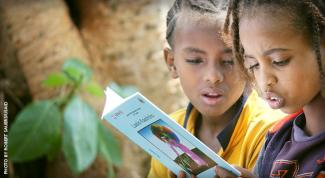OVERVIEW
Ethiopia is a diverse country with a population of 115 million people and over 90 ethnic and linguistic groups, presenting major opportunities and challenges for the education sector. Ethiopia’s young people are the majority of the population; approximately 40 percent of Ethiopia’s population is under the age of 15, with another 32 percent between the ages of 15-29.
In the last two years, Ethiopia’s education systems have suffered significant setbacks due to overlapping crises of armed conflict, drought, and COVID-19. Eight thousand schools have been damaged, looted and destroyed since 2021, denying millions of children and youth of their right to an education. Small businesses and industries have been devastated, stifling young adults’ opportunities for productive livelihoods. Since the onset of these shocks, many children, youth, and their families also faced exposure to violence. Children and youth outcomes are showing signs of decline. Despite major progress Ethiopia made during the last decade towards achieving universal primary school enrollment, more than 29 percent of 7 to 14-year-old children were out of school in the 2020/2021 school year due to recent crises. Children’s learning has also suffered. The 2021 Early Grade Reading Assessment showed 13 percent of children in grade two could read with proficiency, down from 25 percent in 2017/2018. Youth underemployment, defined as involuntary part-time work or underutilization of skills, is estimated at 27 percent, with young women twice as likely to be underemployed or unemployed as young men. Left without educational and economic opportunities, many youth have become combatants in conflict. At this critical moment in Ethiopia, education and youth programming is more important than ever.
Education plays a singular role in preventing further violence against children and youth, while also mitigating the negative psychological impacts associated with exposure to conflict. USAID/Ethiopia is investing in pathways to recovery and peace for young Ethiopians at three key stages of their lives: 1) early childhood, 2) primary years, and 3) adolescence and young adulthood. As Ethiopia continues to move forward and develop, equipping the future working generation with foundational skills and preparing them for employment will be fundamental to ensuring sustainable peace and long-term economic development.
ACTIVITIES
USAID/LEGO Foundation Childhood Development will increase opportunities for preschool aged young children (ages 4-6) to participate in quality play-based, pre-primary programming that increases their overall well-being and improves their early learning outcomes and holistic development skills. USAID/Ethiopia and the LEGO Foundation are co-funding and co-managing the activity. Save the Children is implementing this activity from 2022-2027.
USAID Reading for Ethiopia’s Achievement Developed (READ II) Education Recovery provides access to education for children and youth affected by the northern conflict with focus on Amhara, Afar and Tigray. READ II establishes temporary learning centers for IDP children and youth, furnishes schools with learning materials, and equips teachers and communities with the skills to provide critical psychosocial support for children and youth. Creative Associates is implementing this activity from 2018-2024.
USAID Integrated Youth Activity (Kefeta) aims to empower two million youth in 18 urban centers across Ethiopia to advance their own social and economic development. Kefeta builds youth capacity for advocacy and agency, creates new economic opportunities for youth, and increases access to youth-friendly services. Amref Health Africa is implementing this activity from 2021-2026.

